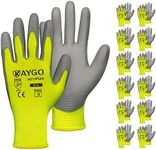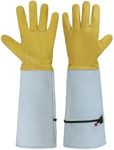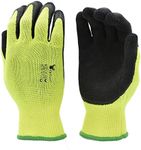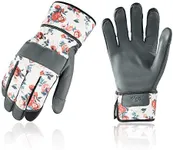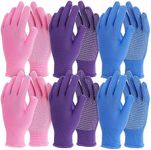Buying Guide for the Best Garden Gloves
Choosing the right garden gloves is essential for ensuring comfort, protection, and efficiency while working in your garden. The right pair of gloves can protect your hands from thorns, chemicals, and other hazards, while also providing the dexterity needed for delicate tasks. Here are some key specifications to consider when selecting garden gloves, along with explanations to help you make the best choice for your needs.MaterialThe material of garden gloves is crucial as it determines the level of protection, comfort, and durability. Common materials include leather, cotton, rubber, and synthetic fabrics. Leather gloves are durable and offer excellent protection against thorns and rough surfaces, making them ideal for heavy-duty tasks. Cotton gloves are lightweight and breathable, suitable for light gardening tasks. Rubber gloves provide good protection against chemicals and are waterproof, making them perfect for working with wet soil or pesticides. Synthetic fabrics often combine the benefits of different materials, offering a balance of protection, comfort, and flexibility. Choose the material based on the type of gardening tasks you perform most frequently.
Fit and SizeThe fit and size of garden gloves are important for ensuring comfort and dexterity. Gloves that are too tight can restrict movement and cause discomfort, while gloves that are too loose can slip off or make it difficult to handle tools. Garden gloves come in various sizes, typically ranging from small to extra-large. To find the right fit, measure the circumference of your hand around the knuckles and compare it to the sizing chart provided by the manufacturer. A well-fitting glove should be snug but not restrictive, allowing you to move your fingers freely and grip tools securely.
GripGrip is an important feature in garden gloves as it affects your ability to hold and manipulate tools and plants. Gloves with textured palms or fingers provide better grip, reducing the likelihood of tools slipping from your hands. This is particularly important when working with wet or muddy conditions. Look for gloves with rubberized or silicone coatings on the palms and fingers for enhanced grip. If you perform tasks that require precision, such as planting seeds or handling delicate plants, choose gloves with a finer texture that offers both grip and dexterity.
DurabilityDurability is a key factor to consider, especially if you engage in heavy-duty gardening tasks. Durable gloves are made from high-quality materials that can withstand wear and tear, protecting your hands from cuts, abrasions, and punctures. Leather and synthetic gloves are generally more durable than cotton gloves. Check for reinforced stitching and double-layered areas, particularly on the fingertips and palms, as these are the parts that experience the most stress. If you garden frequently or work with tough plants and tools, investing in a durable pair of gloves will save you money in the long run.
Water ResistanceWater resistance is an important feature if you often work with wet soil, water plants, or handle chemicals. Water-resistant gloves keep your hands dry and comfortable, preventing skin irritation and providing better grip. Rubber gloves are naturally waterproof, while some synthetic gloves have water-resistant coatings. If you need gloves for tasks involving water, choose a pair that offers good water resistance without compromising on flexibility and comfort.
BreathabilityBreathability is essential for keeping your hands cool and comfortable, especially during long gardening sessions or in hot weather. Breathable gloves allow air to circulate, reducing sweat and preventing your hands from becoming clammy. Cotton gloves are highly breathable but may lack durability. Synthetic gloves often incorporate breathable materials or mesh panels to enhance airflow. If you garden in warm climates or tend to sweat a lot, prioritize gloves with good breathability to maintain comfort.
